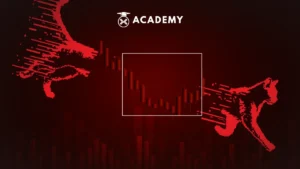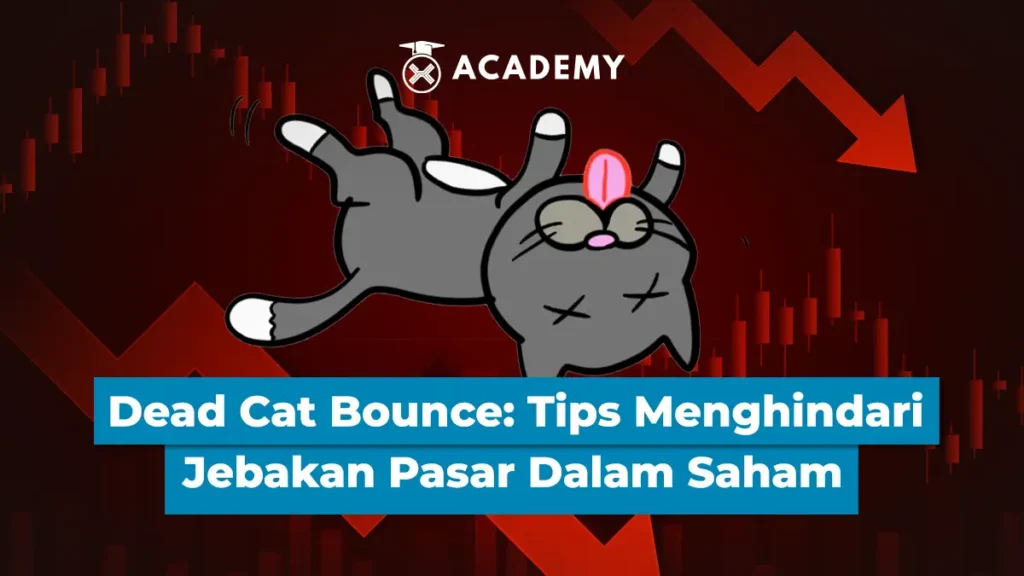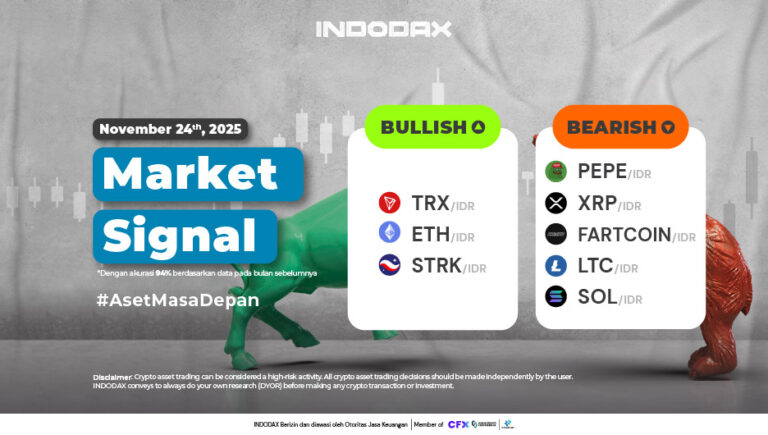Dead cat bounce is a term used in stock market analysis to describe a situation where a stock price that has experienced a sharp decline shows a temporary rebound before falling further.
This term reflects that even in very bad conditions, sometimes prices will rise for a moment, similar to how a cat that falls from a height may bounce a little before falling again.
The phenomenon of dead cat bounce in stocks is one of the things that investors fear. For those who are experienced, this may be known as a condition that can trap investors in an unfavorable situation.
What is Dead Cat Bounce?

Dead cat bounce is an investment term that refers to a temporary rise in the price of a stock or other asset during a prolonged period of decline.
The dark term comes from the idea that if it falls far enough, even a dead cat will bounce. In the context of investing, a dead cat bounce is considered a “deceptive rally.”
This phenomenon can tempt investors to invest their money in a troubled company. Technically, a dead cat bounce can only be identified after it has occurred.
A “bounce” itself refers to a short-term price increase followed by a decline. The second decline takes the stock price to a new low.
Until the second decline occurs, there is no way to know whether the stock price increase is a dead cat bounce or the beginning of a sustained recovery in the stock’s value.
Also Read: Getting to Know Nasdaq: The Best Place for Tech Stocks
Causes of Dead Cat Bounce
Dead cat bounce can occur due to various factors that affect market dynamics. Understanding the causes is important for investors to avoid traps that may arise from this phenomenon.
Here are some factors that can cause dead cat bounces that you need to know.
Dead cat bounce occurs due to several factors that interact in the market, including many investors who tend to react to price declines.
Then, speculative purchases without in-depth analysis and insubstantial news or rumors that can trigger emotional reactions from investors.
The role of investors who incorrectly predict the lowest point of the market
Many investors try to determine when stock prices hit their lowest point before they start rising again.
When they believe that prices have bottomed out, they start making purchases, which pushes stock prices up temporarily.
However, if their predictions are wrong, the increase is only temporary and is followed by a further decline, creating the illusion that recovery has occurred even though the downward trend is still continuing.
Also Read: Dissecting 8 Types of Stocks: Which One is Right for You?
Unsustainable buying activity by investors
The price increase seen in a dead cat bounce is often driven by unsustainable speculative buying. Investors may be tempted to buy stocks at seemingly cheap prices after a sharp decline.
However, if this buying is not supported by improvements in the company’s fundamentals or broader market sentiment, the price increase will quickly recede, leading to a deeper decline afterward.
How to Detect a Dead Cat Bounce
For an investor, there is a tendency to buy stocks when the price is estimated to have reached its lowest point. However, identifying the lowest point of the market is not as easy as imagined.
Instead of getting profitable stocks, many investors are actually trapped in the dead cat bounce phenomenon. This phenomenon is often only recognized after it occurs. Here are some ways to detect a dead cat bounce.
1. The importance of studying previous price patterns
The most effective method to recognize this pattern is to study the patterns that have occurred previously. Although stock prices can fluctuate and have unique characteristics, many patterns tend to be consistent.
By frequently observing these patterns, smart investors will find it easier to understand how they work before making decisions.
Also Read: American Stock Exchange Hours Indonesian Time
2. Analysis techniques such as resistance and support lines
Resistance or resistance levels are price points that limit further price increases, while support is a price point that prevents further declines.
Smart investors can wait for a true breakout on these two lines. If the price manages to break through the resistance (breakout) then the possibility of a dead cat bounce can be avoided.
However, on the other hand, if the price continues to decline and passes the support level (breakdown), then a dead cat bounce has the potential to occur.
3. Using technical analysis and indicators to identify reversal signals
It is important to continue to do technical analysis. Wise investors can use oscillator indicators to help identify whether there is a reversal signal or not.
4. Observing the movement of short sellers as an indication of a potential price decline
Short sellers are parties who profit when the price of an asset falls. The number of short sellers can be an indication that the price of the asset is likely to decline.
Also Read: Top 7 American Blue Chip Stocks with the Largest Dividends
How to Get Out of a Dead Cat Bounce

When caught in a dead cat bounce situation, there are several steps that can be taken to get out of the condition. Here are some strategies to consider.
1. Cut loss strategy when the price falls below support
The first step that can be taken is to secure capital by cutting losses. If you are worried about losses, check your entire investment portfolio.
If the return on the portfolio is sufficient to cover the losses, then you should cut losses on all assets that are trapped when a breakdown occurs.
2. Selling assets in the resistance area to minimize losses
If you are caught in a dead cat bounce and have not sold assets when a breakdown occurs, consider selling in the downtrend resistance area.
3. Averaging down as a short-term strategy to reduce the average cost of purchases
This strategy can be risky because you need to buy more assets when the price falls to reduce the average cost of purchases. However, averaging down should only be done if you are sure that the asset price will rebound in the near future.
Real-Life Examples of Dead Cat Bounces
To better understand the dead cat bounce phenomenon, let’s look at some real-life examples of stock price movements that reflect the pattern.
Cisco Systems’ stock price movement after the dot-com crash
Quotinginvestopedia.com, one example of a dead cat bounce occurred when Cisco Systems’ stock price peaked at $82 per share in March 2000, before falling to $15.81 in March 2001 amid the dot-com crash.
Cisco experienced many dead cat bounce phenomena in the following years. The stock recovered to $20.44 in November 2001, but fell back to $10.48 in September 2002.
Moving forward to June 2016, Cisco’s stock price was trading at $28.47 per share, just a third of its peak during the tech bubble in 2000.
Also Read: Top 3 High Dividend Stocks to Buy Now
The stock market during the early days of the COVID-19 pandemic in 2020 is an example of a classic Dead Cat Bounce
A more recent example of a dead cat bounce is the price action in the market following the emergence of the global COVID-19 pandemic in the spring of 2020.
Between the week of February 21 and February 28, 2020, the US market lost about 12% as news began to emerge and panic set in. The following week, the market rose 2%, giving some the impression that the worst was over.
However, this is a classic example of a dead cat bounce as the market then fell an additional 25% over the next two weeks. It wasn’t until the summer of 2020 that the market began to recover.
Also Read: What is the S&P 500? A Complete Beginner’s Guide to Investing!
Limitations of Identifying a Dead Cat Bounce
The biggest challenge in identifying a dead cat bounce is that it can’t be done reliably until the phenomenon has already occurred.
For example, after the S&P 500 plunged sharply in March 2020 due to the pandemic and then began to reverse course, many analysts initially dismissed the rally as a dead cat bounce.
With the S&P 500’s value rising rapidly since then, it is now clear—in retrospect—that those analysts were wrong. It is also important to understand that a dead cat bounce is not a sign of a strong trend reversal.
While a dead cat bounce creates the illusion of a temporary recovery, a true trend reversal is characterized by sustained increases in demand and improvements in a company’s fundamentals.
Accurately depicting both of these phenomena is critical, with the goal of not trapping investors in costly decisions.
Conclusion
Well, that was an interesting discussion about Dead Cat Bounce: Tips for Avoiding Market Traps in Stocks that you can read in full at the Crypto Academy at INDODAX Academy.
In conclusion, in dealing with the dead cat bounce phenomenon, it is important for investors to remain vigilant. Although this pattern can seem tempting, improper recognition of market conditions can result in detrimental investment decisions.
Investors face great risks when trying to determine the market’s lowest point. A wrong step can lead to being trapped in an unfavorable situation, where stock prices can fall again after a temporary increase.
Therefore, a cautious approach based on fundamental analysis is more advisable than relying solely on speculation.
As additional information, there is currently interesting news for you, namely INDODAX will soon introduce a new investment option with the presence of leading stocks from the United States.
Now, in addition to investing in crypto, you can also expand your portfolio with more than 50 stocks from major US companies and all of them can be accessed through one INDODAX account.
FAQ
1.What is a Dead Cat Bounce?
A dead cat bounce is a temporary price recovery after a sharp decline, followed by a further decline.
2.Why does a Dead Cat Bounce occur?
This happens because investors wrongly predict the market’s bottom, buy assets, but the increase is not sustainable.
3. How to detect a Dead Cat Bounce?
Use resistance and support lines and technical analysis to identify price patterns before making a decision.
4. What to do if you are caught in a Dead Cat Bounce?
Strategies such as cut loss, selling at resistance areas, or averaging down can help minimize losses.
5.What is the difference between a Dead Cat Bounce and a trend reversal?
A dead cat bounce is a temporary rise in the middle of a downtrend, while a trend reversal is a change in the direction of a longer trend.





 Polkadot 8.91%
Polkadot 8.91%
 BNB 0.45%
BNB 0.45%
 Solana 4.80%
Solana 4.80%
 Ethereum 2.37%
Ethereum 2.37%
 Cardano 1.65%
Cardano 1.65%
 Polygon Ecosystem Token 2.13%
Polygon Ecosystem Token 2.13%
 Tron 2.85%
Tron 2.85%
 Market
Market


